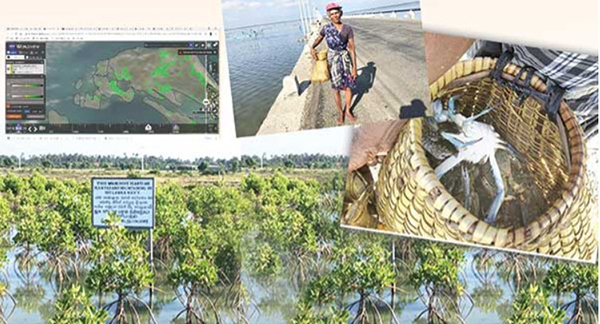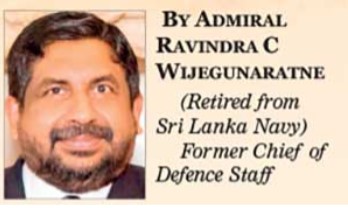Re-foresting in North and de-foresting in South-by Admiral Ravindra C Wijegunaratne

Source:Island
My former Personal Security Officer (PSO), Commander Chatura Gamage, RSP and five Bars, from the elite Sri Lanka Navy Special Boat Squadron, who has an MSc in GIS and Remote Sensing from the Peradeniya University, gave me a call. He was delighted. ” Sir, it’s working! I can see our Jaffna islands growing in size! I will get you the Google pictures soon.”
I was very happy. A small project we started in 2011 in Northern islands, Karainagar, Eluvativu, Analativu, Nayanativu (Nagadeepa), Punkudativu, Kyts and Mandativu is giving rich dividends after 10 years.
In 2011, we saw the mangroves on the Jaffna islands being destroyed by some persons. They were driven by a desire to make money. As there was a shortage of firewood, especially for bakeries on the Jaffna main land, the mangroves were cut for firewood. Mangrove wood is ideal for bakeries as it is hard. Those days (2011) we observed heavy loads of dry mangrove wood being transported on bicycles via causeways.

With the support of the police, the Sri Lanka Navy (in charge of security on the Northern islands) put an end to this illegal practice. Now, the mangroves are growing freely and lavishly, increasing the size of the islands and protecting the shell fish breeding grounds. You may be aware that crabs, shrimps and prawns lay their eggs in mangrove areas so that they will be safe from the big fish and other predators.
My deputy in Northern Naval Area in 2011, when I was Commander Northern Naval Area, Admiral Piyal De Silva (former Navy
Commander and now our Ambassador to Afghanistan), came up with a unique plan to grow mangroves. We started the project near the Karainagar causeway. A few hundred of mangrove saplings were planted as per instructions given by the experts on the subject. Within three months, the project became a failure. I told Piyal to try again. He did but we failed again. Only six out of hundred saplings survived.
Following a careful study, Piyal when he was the Northern Commander in 2017, figured out what had gone wrong and found a solution. Due to flooding and ebbing water of the lagoon every six hours, the roots of the newly planted mangrove saplings were disturbed. This will not allow saplings to grow in muddy waters. The solution was to plant four-foot sticks in the mud and tie the saplings to them to make them stable. This method worked, and now Karainagar lagoon has more than 600 fully grown mangrove plants.
One of the people who were extremely happy about our successful project was Chinnama, an elderly woman who harvest crabs in the lagoon to eke out a living. Those days when we were young officers, we used to buy fresh prawns and crabs from her during weekends. This seafood goes well with Thal palm toddy. A crab exporter to Singapore buys her catch at the rate of only Rs. 120 a kilo! But she is happy.
Re-planted mangroves and Chinnama’s catch were improving. She has become a tireless campaigner for protecting mangroves in the Karainagar lagoon.
The Navy has done something good for the people inhabiting the Northern Islands. They now protect their mangroves from illegal felling. As Chatura observed from a satellite image, the northern islands are growing in size!
In South …
In my book, Read between the lines, I have written in page 42, :When you reach Kumbukkan Oya, you will realise why this river is called ‘Kubukkan Oya’. All you see around are Kumbuk trees, hundreds, if not, thousands of them, on either side of the river. It is a beautiful sight that you will never forget. Thank God ! It’s away from the human gaze; otherwise, all these trees would disappear soon and the timber will be used to construct the floors of wealthy mansions !
I have realised that nature’s worst enemies are the wealthy humans.”
That was in December 2018. I do not know whether my predictions were correct or not. But I saw a huge Kubukkan tree, may be more than 300 years old uprooted by strong winds, miraculously saving “Kuda Kabillitha “Murugan temple, being cut into pieces on the Eastern banks of Kubukkan Oya when I did “Pada Yathra last year (2020). Who is doing this in most protected jungle of our country.
It’s time to learn from the North !
PS : please read my articles dated 26th May 2020 (Sri Lanka expects every man to perform his duty) and 30th July 2020 (Pada Yathra with a difference) in The Island e- paper archives for more details).







